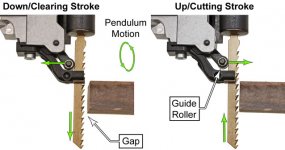I watched a vid of Paul Marcel tensioning the blade guides. My blade seems to sit really far forward compared to his. The photo shows the blade sitting as far back as I can push it. Seems most of the blade sits outside or forward of the blocks, in the "V" part of the guides. Is this the normal position? I only get a mm or two of the blocks to contact the blade.



